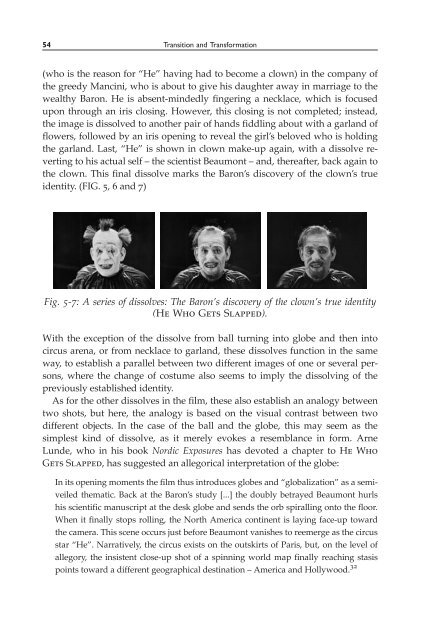FILM FILM - University of Macau Library
FILM FILM - University of Macau Library
FILM FILM - University of Macau Library
You also want an ePaper? Increase the reach of your titles
YUMPU automatically turns print PDFs into web optimized ePapers that Google loves.
54 Transition and Transformation<br />
(who is the reason for “He” having had to become a clown) in the company <strong>of</strong><br />
the greedy Mancini, who is about to give his daughter away in marriage to the<br />
wealthy Baron. He is absent-mindedly fingering a necklace, which is focused<br />
upon through an iris closing. However, this closing is not completed; instead,<br />
the image is dissolved to another pair <strong>of</strong> hands fiddling about with a garland <strong>of</strong><br />
flowers, followed by an iris opening to reveal the girl’s beloved who is holding<br />
the garland. Last, “He” is shown in clown make-up again, with a dissolve reverting<br />
to his actual self – the scientist Beaumont – and, thereafter, back again to<br />
the clown. This final dissolve marks the Baron’s discovery <strong>of</strong> the clown’s true<br />
identity. (FIG. 5, 6 and 7)<br />
Fig. 5-7: A series <strong>of</strong> dissolves: The Baron’s discovery <strong>of</strong> the clown’s true identity<br />
(He Who Gets Slapped).<br />
With the exception <strong>of</strong> the dissolve from ball turning into globe and then into<br />
circus arena, or from necklace to garland, these dissolves function in the same<br />
way, to establish a parallel between two different images <strong>of</strong> one or several persons,<br />
where the change <strong>of</strong> costume also seems to imply the dissolving <strong>of</strong> the<br />
previously established identity.<br />
As for the other dissolves in the film, these also establish an analogy between<br />
two shots, but here, the analogy is based on the visual contrast between two<br />
different objects. In the case <strong>of</strong> the ball and the globe, this may seem as the<br />
simplest kind <strong>of</strong> dissolve, as it merely evokes a resemblance in form. Arne<br />
Lunde, who in his book Nordic Exposures has devoted a chapter to He Who<br />
Gets Slapped, has suggested an allegorical interpretation <strong>of</strong> the globe:<br />
In its opening moments the film thus introduces globes and “globalization” as a semiveiled<br />
thematic. Back at the Baron’s study [...] the doubly betrayed Beaumont hurls<br />
his scientific manuscript at the desk globe and sends the orb spiralling onto the floor.<br />
When it finally stops rolling, the North America continent is laying face-up toward<br />
the camera. This scene occurs just before Beaumont vanishes to reemerge as the circus<br />
star “He”. Narratively, the circus exists on the outskirts <strong>of</strong> Paris, but, on the level <strong>of</strong><br />
allegory, the insistent close-up shot <strong>of</strong> a spinning world map finally reaching stasis<br />
points toward a different geographical destination – America and Hollywood. 32

















